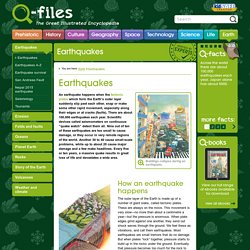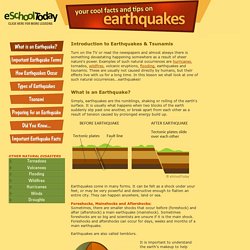

Visit the 'big wet' by camel as the desert blooms. 00:00:00:22KATHY MCLEISH, REPORTER:The Simpson Desert is alive with new life, the landscape transformed by an event that's only happened 3 times in 100 years.00:00:09:18ANDREW HARPER:We could come back here every year for the next 30 years and not see it like this.

It's fantastic.00:00:17:18KATHY MCLEISH:Floodwaters pouring in from Central Queensland and torrential inland rain have filled waterholes and wetlands. Some of the animals and plants which have come to life are rarely seen in the desert. Australia's east coast hit by floods, 2009. Don't Panic: Story and web extras. Earthquakes - Q-files Encyclopedia. Many earthquakes take place where one tectonic plate slides down beneath in another in what is called a subduction zone.

Shock waves are sent out in all directions when, deep under the ground, the locked plates suddenly "give". A subduction zone How an earthquake happens The outer layer of the Earth is made up of a number of giant slabs, called tectonic plates. These are always on the move. P- and S-waves travelling through the Earth's interior Shock waves The sudden jolt of a quake usually lasts no more than a few minutes and may be over in just a few seconds.
Sitman, Jennifer / Volcanoes. Volcano Tidbit - A volcano is an opening in Earth's surface through which melted rock, hot gases, rock fragments, and ash burst forth, or erupt. - A violent eruption can release rivers of red- hot molten rock, hissing jets of poisonous gas, curling clouds of thick gray ash, and explosions of scorched rock.

How do such mountains of fire form? - Volcanoes come from Earth's hot interior. They start 37 to 100 miles below the surface. . - Under pressure from the weight of surrounding rock, the magma melts or forces a channel into weak or cracked rock above it. . - After an eruption, a volcano usually collapses into a bowl-shaped mouth called a crater. What about volcanic mountains? - Many of the mountains in the Andes chain in South America are volcanoes. . - Volcanic mountains can form at different types of boundaries. . - Volcanic mountains can form away from late boundaries as well. Faultline: Theory of Plate Tectonics. Earthquake Facts. The origin of the name of the San Andreas Fault is often cited as the San Andreas Lake.

Earthquake Pictures, Wallpapers, Downloads. Earthquakes for Kids. Videos. What is an Earthquake. Introduction to Earthquakes & Tsunamis Turn on the TV or read the newspapers and almost always there is something devastating happening somewhere as a result of sheer nature's power.

Examples of such natural occurrences are hurricanes, tornados, wildfires, volcanic eruptions, flooding, earthquakes and tsunamis. These are usually not caused directly by humans, but their effects live with us for a long time. In this lesson we shall look at one of such natural occurrences...earthquakes! What is an Earthquake? Simply, earthquakes are the rumblings, shaking or rolling of the earth's surface. Earthquakes come in many forms. Foreshocks, Mainshocks and Aftershocks: Sometimes, there are smaller shocks that occur before (foreshock) and after (aftershock) a main earthquake (mainshock). Earthquakes are also called temblors. It is important to understand the earth’s makeup to help understand earthquakes better.
Disasters - preparedness/Civil Defence. Image: Earthquake survival kit by Global X on Flickr We have selected these online resources to support you when you need information relating to civil defence and preparing for disasters.

SCIS 1702159 See also Earth science - Volcanoes; Earth science - Tsunami; Disasters - Natural; Disasters – New Zealand; Extreme weather The Environmental Protection Agency in the United States lists ways to reduce risks to health and the environment from natural disasters. Suggested level: intermediate, Get Through The Get Through website is designed to help people get ready and be prepared in a disaster situation, it includes; household emergency plans, checklists, how to prepare and what to have in a getaway kit. Suggested level: intermediate, secondarywww.getthru.govt.nz LandSAR A brief history of the Land Search and Rescue organisation and what they do. Suggested level: primary, intermediate, secondarywww.landsar.org.nz/ Layers of the Earth.
NASA Predicting Weather. Documentary about regenerating large-scale damaged ecosystems. Meet John D.

Liu, the environmental film maker who says "it is possible to regenerate large-scale damaged ecosystems. " The documentary film looks at restoration projects in China, Africa, South America and the Middle East, who aim to rejuvenate eroded landscapes. Permaculture teacher Geoff Lawton, who stars in the film states: "The world gets more and more complicated all the time but the solution to fix the major problems of the worlds ecosystems remains reasonably simple. We have to go ahead on a major scale now. Everybody can do their back yard but we have to change the major eroded landscapes into the functional ecosystems they should be. " Spreading the message of change. Water. BBC Bitesize - Early and 1st level People, place and environment - Natural disasters.